
A new species of bent-toed gecko has been discovered by biologists on an isolated mountain in northern Cambodia.
Describing the find as “extremely unexpected”, scientists have warned the species could be lost as suddenly as it was detected because of the gold mining which threatens the small lizard’s forest habitat.
Biologist Thy Neang discovered the reddish-brown gecko with grey stripes and distinctive yellow spots – since named Cyrtodactylus phnomchiensis – during a field survey of the Prey Lang Wildlife Sanctuary on the Phnom Chi mountain.
“It was an extremely unexpected discovery. No one thought there were undescribed species in Prey Lang,” said Mr Neang.
The geckos were found to belong to the C irregularis family that includes at least 19 species across southern and central Vietnam, eastern Cambodia, and southern Laos. However, this is the first member to be found west of the Mekong River.
They were also physically different from C ziegleri, their closest relative. But the difference was properly confirmed with DNA testing, as part of a collaboration with North Carolina Museum of Natural Sciences in the US.
Researchers named the species Cyrtodactylus phnomchiensis after Phnom Chi, which consists of an isolated mountain and a few smaller hills.
The forest habitat in Phnom Chi remains in relatively good condition, but the scientists behind the discovery said small-scale, illegal gold extraction around its base threatens the newly discovered species.

Many of these newly-recognised species of gekkonid lizards are believed to be unique to very small areas. Cyrtodactylus phnomchiensis is thought to live in a habitat of just 45 square kilometres within the Prey Lang Wildlife Sanctuary.
Mr Neang argued that the find underscores the importance of the sanctuary for biodiversity conservation, and said it should be assessed for endangered status because of the ongoing threats to its habitat.
He said: “This exciting discovery adds another reptile species to science for Cambodia and the world. It also highlights the global importance of Cambodia’s biodiversity and illustrates the need for future exploration and biological research in Prey Lang.”
Dr Bryan Stuart, of the North Carolina Museum of Natural Sciences, said: “When Neang first returned from fieldwork and told me that he had found a species in the C irregularis group so far west of the Mekong River in Cambodia, I did not believe it.
“His discovery underscores how much unknown biodiversity remains out there in unexpected places. Clearly, Prey Lang Wildlife Sanctuary is important for biodiversity and deserves attention.”







